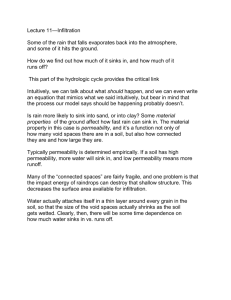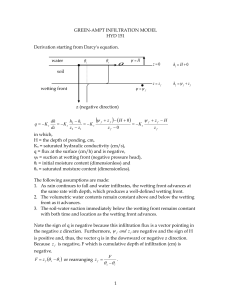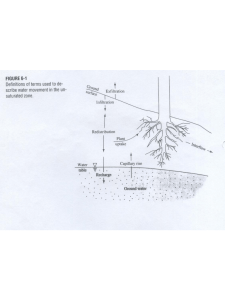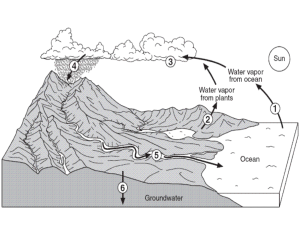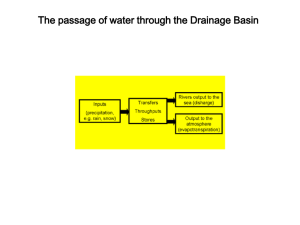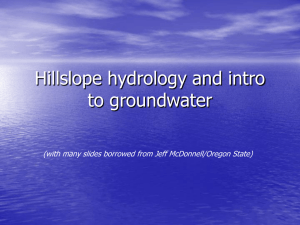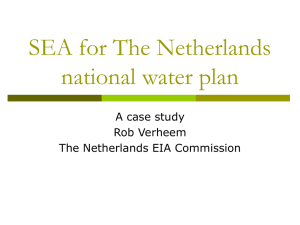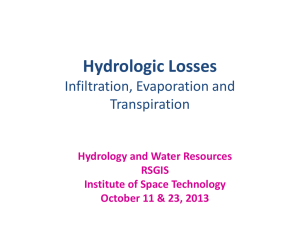LAB05 - CUNY.edu
advertisement
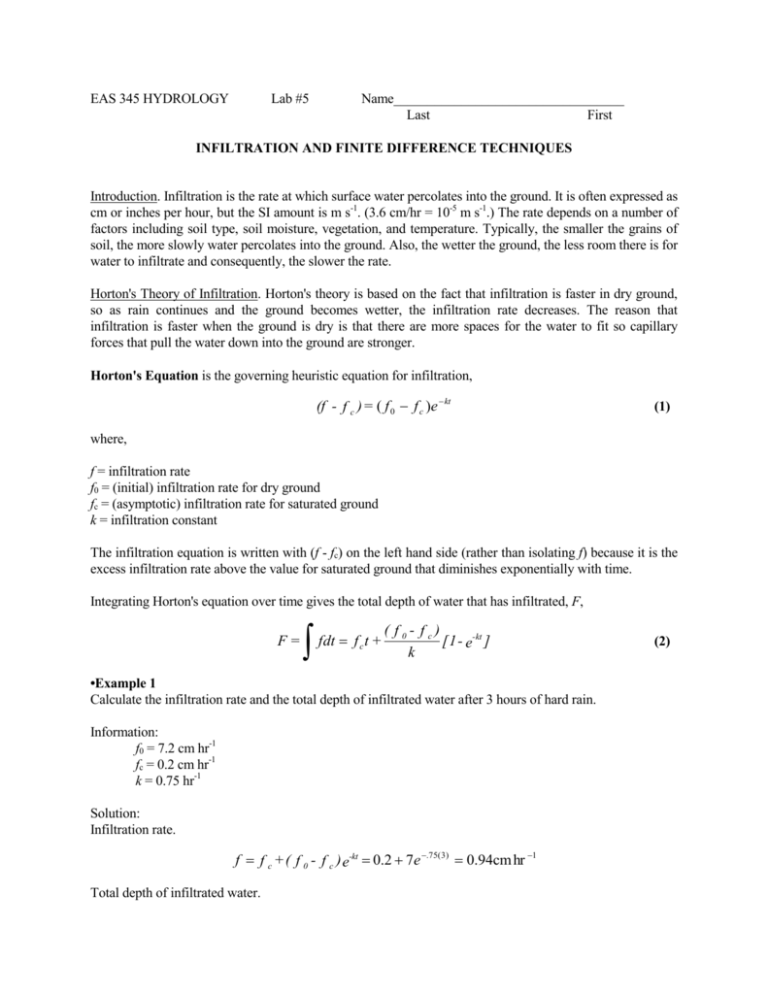
EAS 345 HYDROLOGY Lab #5 Name__________________________________ Last First INFILTRATION AND FINITE DIFFERENCE TECHNIQUES Introduction. Infiltration is the rate at which surface water percolates into the ground. It is often expressed as cm or inches per hour, but the SI amount is m s-1. (3.6 cm/hr = 10-5 m s-1.) The rate depends on a number of factors including soil type, soil moisture, vegetation, and temperature. Typically, the smaller the grains of soil, the more slowly water percolates into the ground. Also, the wetter the ground, the less room there is for water to infiltrate and consequently, the slower the rate. Horton's Theory of Infiltration. Horton's theory is based on the fact that infiltration is faster in dry ground, so as rain continues and the ground becomes wetter, the infiltration rate decreases. The reason that infiltration is faster when the ground is dry is that there are more spaces for the water to fit so capillary forces that pull the water down into the ground are stronger. Horton's Equation is the governing heuristic equation for infiltration, (f - f c ) = ( f 0 f c )e kt (1) where, f = infiltration rate f0 = (initial) infiltration rate for dry ground fc = (asymptotic) infiltration rate for saturated ground k = infiltration constant The infiltration equation is written with (f - fc) on the left hand side (rather than isolating f) because it is the excess infiltration rate above the value for saturated ground that diminishes exponentially with time. Integrating Horton's equation over time gives the total depth of water that has infiltrated, F, F= fdt f c t + ( f0- fc) [1 - e- kt ] k •Example 1 Calculate the infiltration rate and the total depth of infiltrated water after 3 hours of hard rain. Information: f0 = 7.2 cm hr-1 fc = 0.2 cm hr-1 k = 0.75 hr-1 Solution: Infiltration rate. f f c + ( f 0 - f c ) e-kt 0.2 7e .75(3) 0.94cm hr 1 Total depth of infiltrated water. (2) F = f ct + ( f0- fc) 7 [1 - e-kt ] 0.2(3) [1 e .75(3) ] 8.95 cm k 0.75 Limits to Horton's Theory Horton's equation and integral assume that the rainfall rate, R is greater than the infiltration rate throughout the rain. If at any time the rainfall rate is slower than the infiltration rate, the ground will lose some water to lower levels, and Horton's theory must be modified. Simple Model of Infiltrating Water Infiltration can be modeled by a layer of ground in which water enters through the top at a rate, f = fin and leaves through the bottom (into the water table) at a rate fout. As soon as any water is stored in the ground, storage S > 0 and, f out f c (3) The depth of water stored in the layer, S, is equal to the total depth of infiltration, F minus the depth of water that has leaked out the bottom of the layer. Except in very permeable soil (such as sand or gravel, water leaks out the bottom so slowly, it is safe to assume that during any rainfall, S = F - f ct (4) The infiltration rate, fin is limited by the rainfall rate and by the total amount of stored water in the layer, R f in = min ( f 0 - f c ) ( S max - S) + f c S max (5) R = Rainfall Rate and Smax = maximum depth of water layer can store Solving Horton's Equation yields the value for Smax, S max = f0- fc k (6) The rate at which water is stored in the layer is equal to the infiltration rate minus the outflow rate through the bottom of the layer, or, dS = f in - f out dt (7) The difficulty with this equation is that Eq. (5) for fin is complicated. If rainfall is ever less than the possible infiltration rate, then it is necessary to solve Eq. (7) numerically, using finite difference techniques. Finite Difference Techniques. The secret of finite difference techniques is to replace derivatives by finite differences. This transforms a differential equation into an arithmetic equation that can be solved easily. Solving a differential equation using finite differences involves several steps. 1. Replace all derivatives with differences. 2. Solve the equation for the unknown (generally the future value). 2. Choose a value for the time step (t) or a distance interval. 3. Substitute current values to find the future value of the variable. 4. Iterate, or, update by repeating step 3 as much as needed. The derivative is defined as, dS S(t + t) - S(t) = lim t 0 dt t (8) The finite difference technique assumes that the difference equals the derivative. Then we write the infiltration equation, Eq.(8) in finite difference form and rearrange to solve for S(t+t) because it is the only unknown. Finite Difference Infiltration Equation S(t + t)= S(t) + t( f in - f c ) (9) Finally, overland flow occurs when the rainfall rate is greater than the infiltration rate. In that case, Overland flow = R - f in (10) Now we are ready to solve a problem. •Example 2 Use the finite difference technique to find the infiltration rate, the storage, and the overland flow assuming the same ground conditions as Example 1 and with rainfall rates of, rainfall rate is (a) R = 4 cm/hr (b) R = 8 cm/hr First, solve for Smax using Eq.(6). This yields, S max = f0- fc 7 = = 9.33 cm k 0.75 Then in Column 4 below solve for fin using the bottom line of Eq (5). This tells the maximum possible infiltration rate. But the infiltration rate can never exceed the rainfall rate, R. Therefore, in Column 5 (fin) enter the smaller of the values in Column 3 and 4 t S(t) R fc+(f0-fc)(Smax-S)/Smax fin S(t+t) Rxs 0 0 4 .2+7(9.33-0)/9.33=7.2 4 3.8 0 1 3.8 4 .2+7(9.33-3.8)/9.33=4.3 4 7.6 0 2 7.6 4 .2+7(9.33-7.6)/9.33=1.5 1.5 8.9 2.5 3 8.9 4 Note in the table above that fin is equal to the rainfall rate for the first two time steps. Only when the ground has filled sufficiently with water is the runoff given by the longer expression in Column 4. Note also (see below) that when the rainfall rate is larger than the maximum possible infiltration rate, there is excess rain and overland flow. t S(t) R fc+(f0-fc)(Smax-S)/Smax fin S(t+t) Rxs 0 0 8 .2+7(9.33-0)/9.33=7.2 7.2 7.0 0.8 1 7.0 8 .2+7(9.33-7)/9.33=1.9 1.9 8.7 6.1 2 8.7 8 .2+7(9.33-8.7)/9.33=.67 .67 9.17 7.33 3 9.17 8 EAS 345 HYDROLOGY Lab #5 Name__________________________________ Last First INFILTRATION AND FINITE DIFFERENCE TECHNIQUES In Math Problems, show all work. 1. A) Calculate all required quantities in the sheet for the Ring Infiltrometer Data. B) Plot the data using Excel with f on the y axis (max value = 8 on graph) and time in min on the x axis C) From the graph, estimate f0 = _______________ cm hr-1 and fc = ____________cm hr-1. D) Use Horton's equation together with the values in the table and fo and fc to calculate k. k = _______ 2. Given initial and final infiltration rates fo = 1.25 cm hr-1 fc = 0.05 cm hr-1 and the maximum storage. Smax = _________cm Calculate t S(t) R 0 0 .5 1 .3 2 .2 3 .7 4 .9 5 1.1 6 .6 7 .3 8 .5 9 .4 10 .4 11 .6 12 .5 13 .4 14 .4 15 .2 fc + (f0 - fc)(Smax-S)/Smax Total Runoff or Rainfall Excess Rxs = ___________ cm Total Infiltration F = ______________ cm Total Rainfall Rtot = ____________ cm fin S(t+t) Rxs Ring Infiltrometer Data These data were obtained in a concentric ring infiltrometer experiment on a rice paddy soil during the dry season in Thailand. Water was maintained at a depth of 1.5 cm inside both the inside ring and in the buffer ring. The inside ring had an internal diameter of 26 cm. The area of the experiment was 572 cm2. The experimental data are given I the following table. time (min) 0 1 2 5* 10 20 30 60 90 120 t (hr) 0 0.0167 0.0167 0.0500 Vol H2O (cm3) 0 63 120 269 436 681 862 1153 1298 1440 * Air was observed bubbling out of the ground. F (cm) 0 0.110 DF (cm) ----------------0.110 f (cm/hr) 6.59
